Abstract
Multi-unit recordings of muscle-nerve sympathetic activity (m.s.a) or skin-nerve sympathetic activity (s.s.a) were made in the left peroneal nerve of sixteen healthy volunteers during simulated diving by immersion of the face in a tub of water. The procedure was varied by the use of different water temperatures, by diving with snorkel breathing, by apnoea without diving, and by apnoea with a stream of air against the face instead of immersion in water. Diving for 12 s elicited a pronounced activation of m.s.a., the mean increase from control periods being 360%. The response was stronger with lower water temperatures. Immersion of the whole face evoked a stronger increase in m.s.a. than immersion of mouth and nose only. Diving without apnoea elicited a significant but weaker increase in m.s.a., whereas apnoea only for 12 s did not influence the sympathetic outflow. Cool air against the face during apnoea for 12 s was associated with a significant increase in m.s.a. The increase in m.s.a. usually occurred before the bradycardia. On emersion, m.s.a. ceased abruptly, whereas the bradycardia persisted for a few seconds. Mental arithmetic during diving did not change the m.s.a. response but reduced the bradycardia. M.s.a. increased despite increasing blood pressure levels. On emersion, m.s.a. did not reappear until the pre-diving blood pressure level was attained. S.s.a was inhibited on diving, with concomitant vasodilatation in the skin as recorded in the big toe. It is concluded that the response of m.s.a. to diving is initiated by a central 'pattern recognition' of an input from facial receptors, that this input and the effects of apnoea, acting by mutual reinforcement, maintain the strong sympathetic outflow, and that the mechanism releasing m.s.a. on diving overrides the normal blood pressure regulatory function of m.s.a. Diving exerts differentiated influence on different parts of the sympathetic nervous system, as illustrated by the inhibition of s.s.a.
Full text
PDF

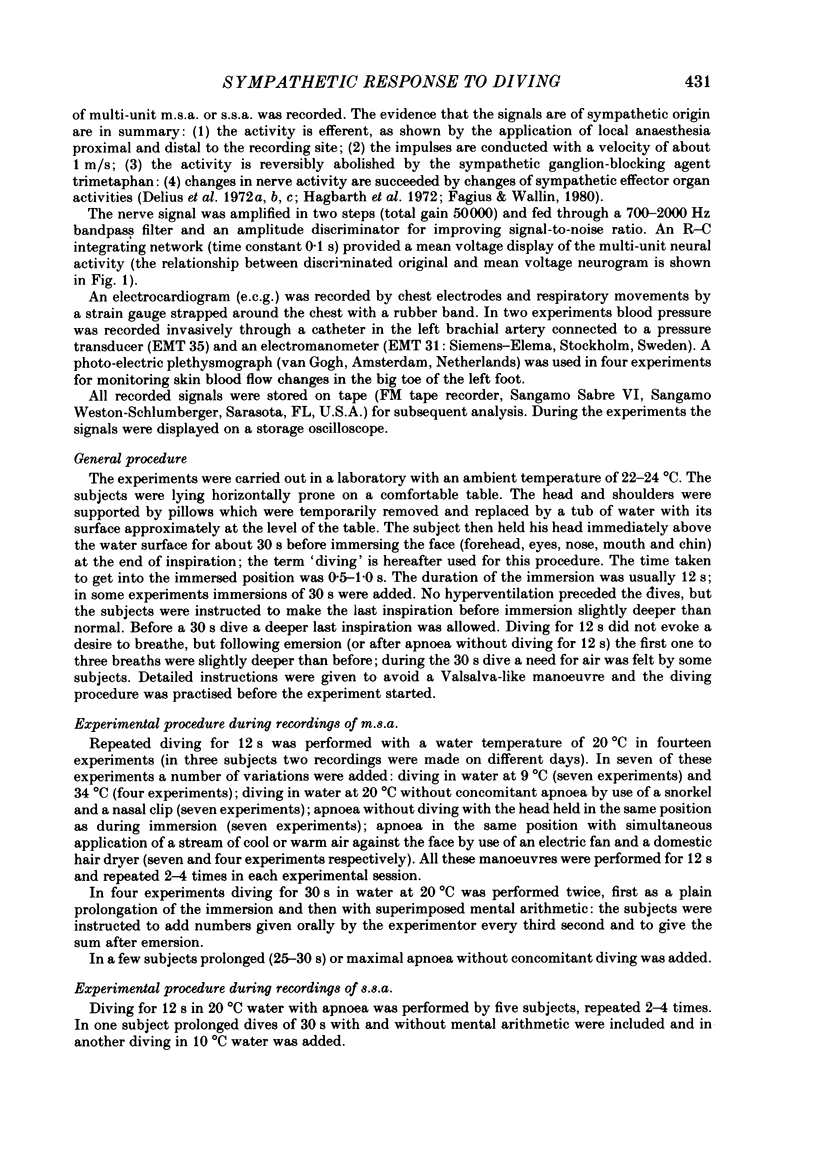
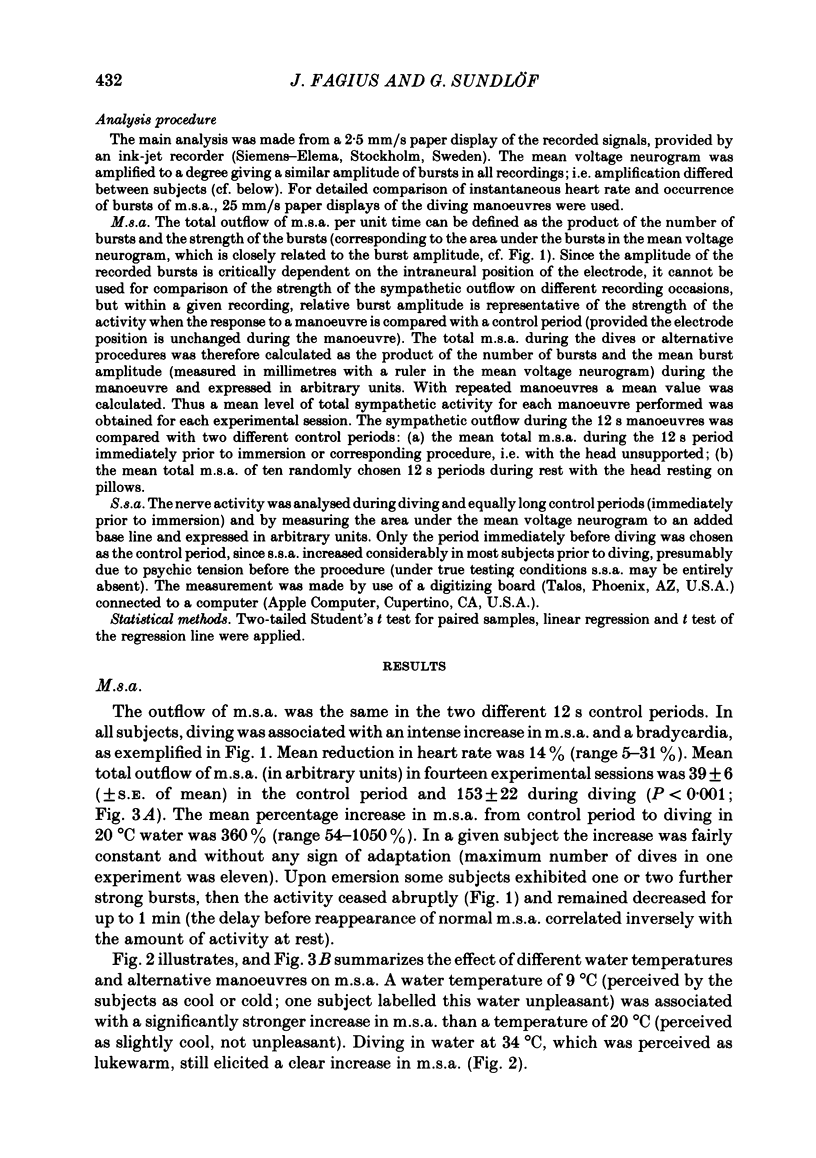


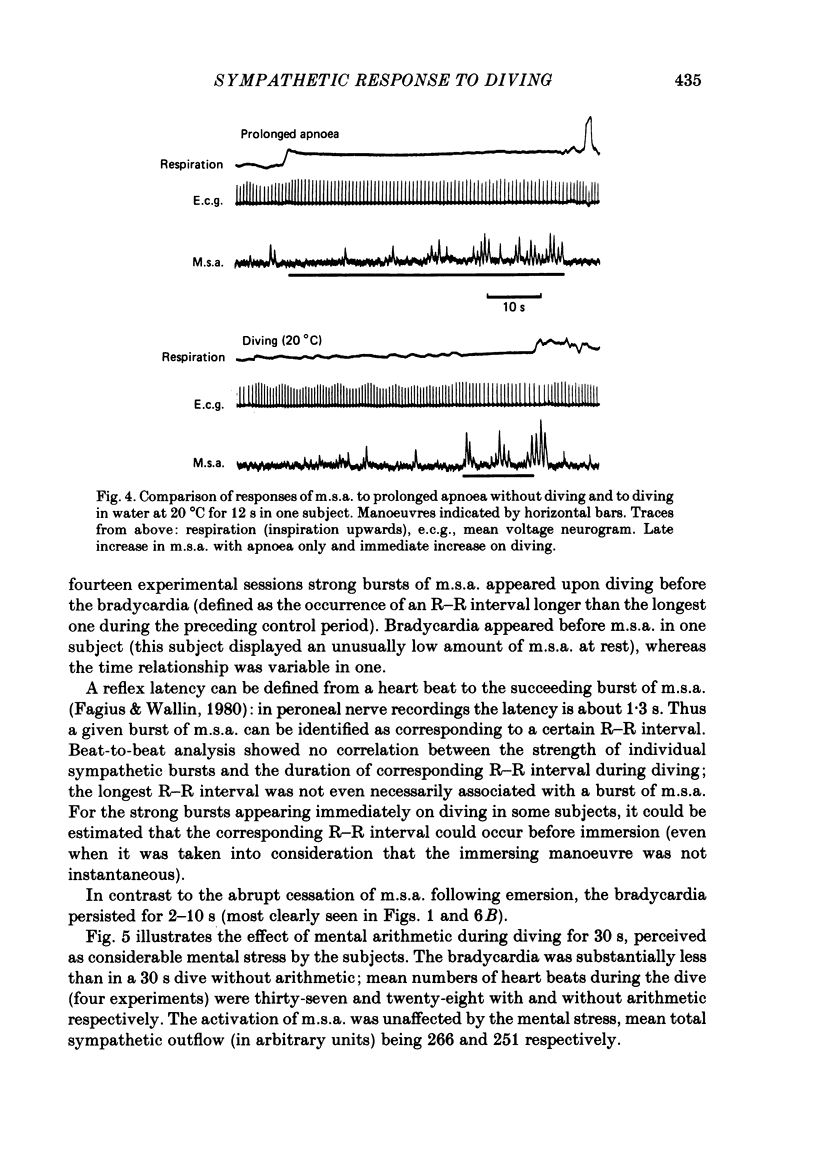
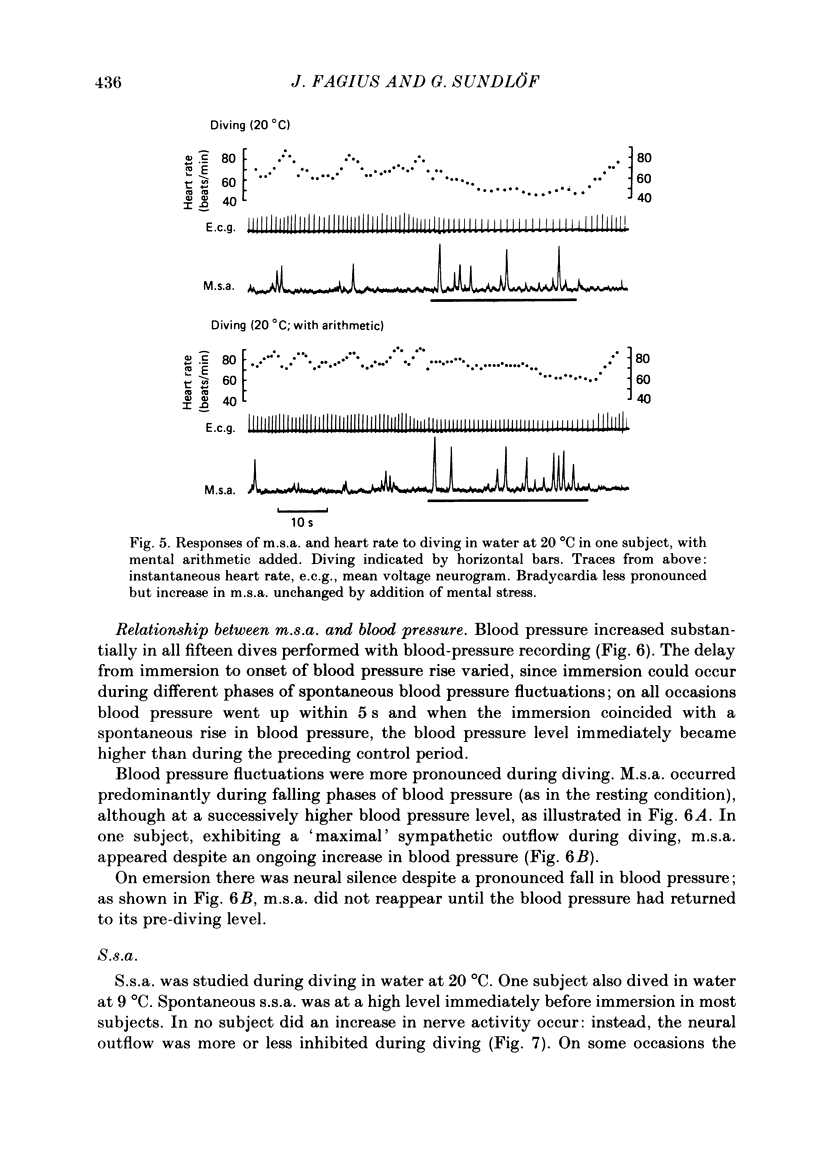
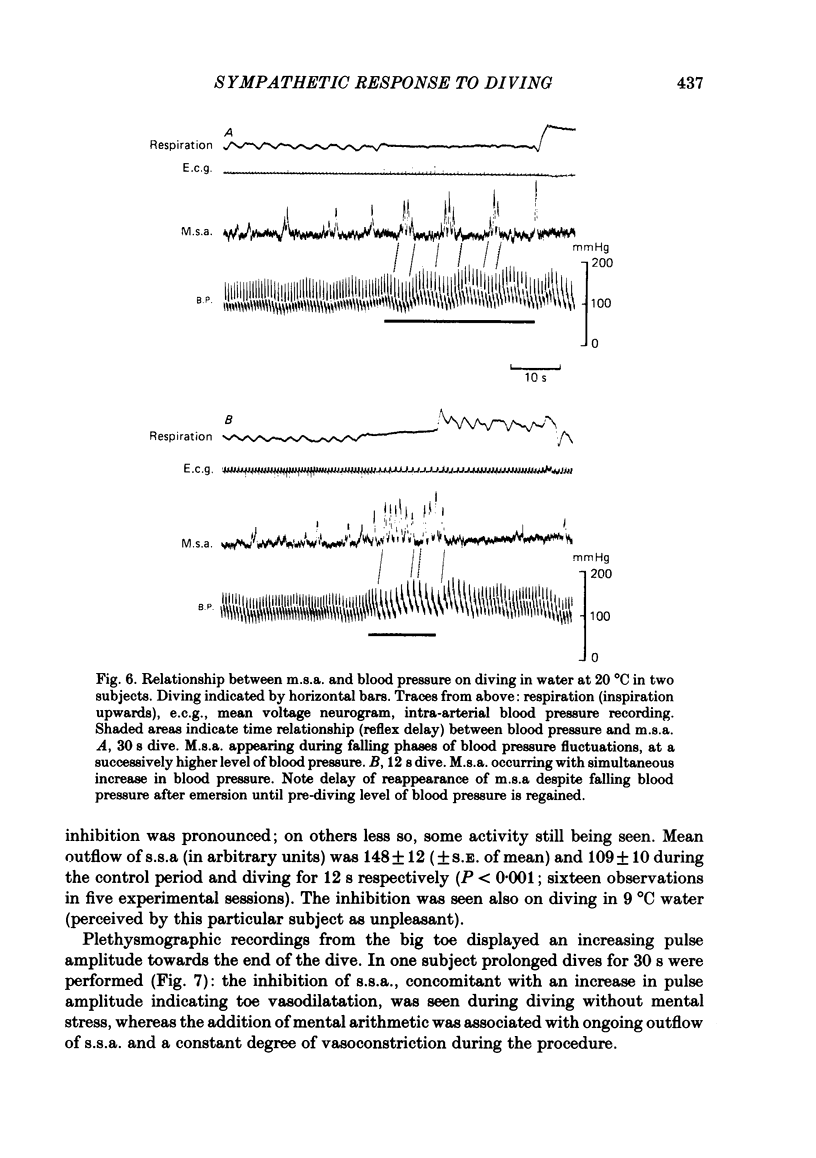
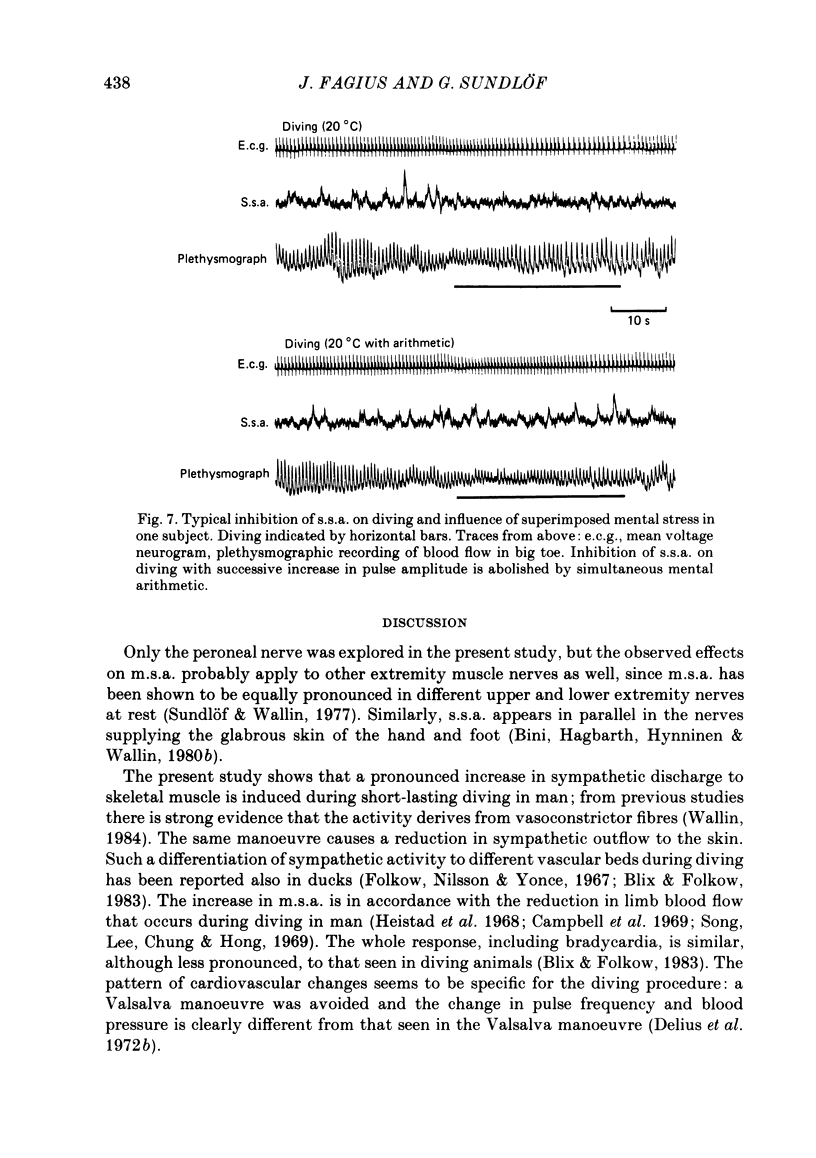
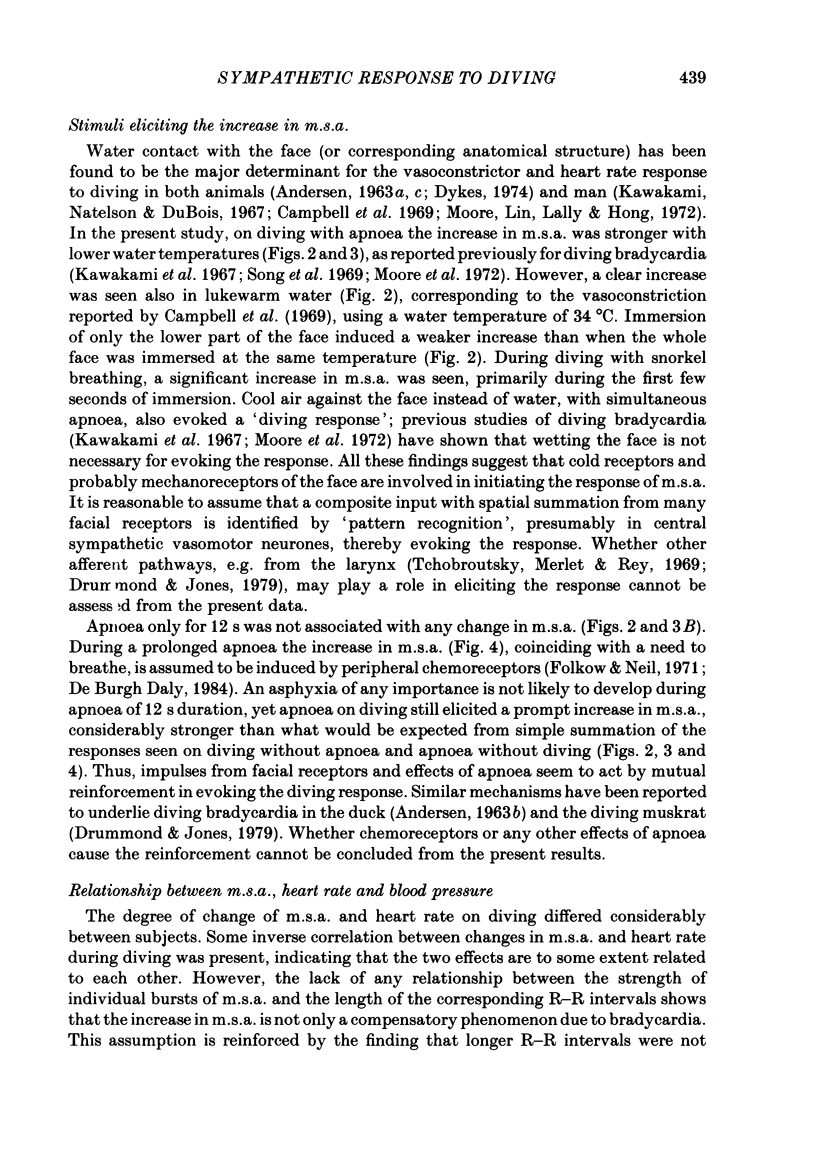

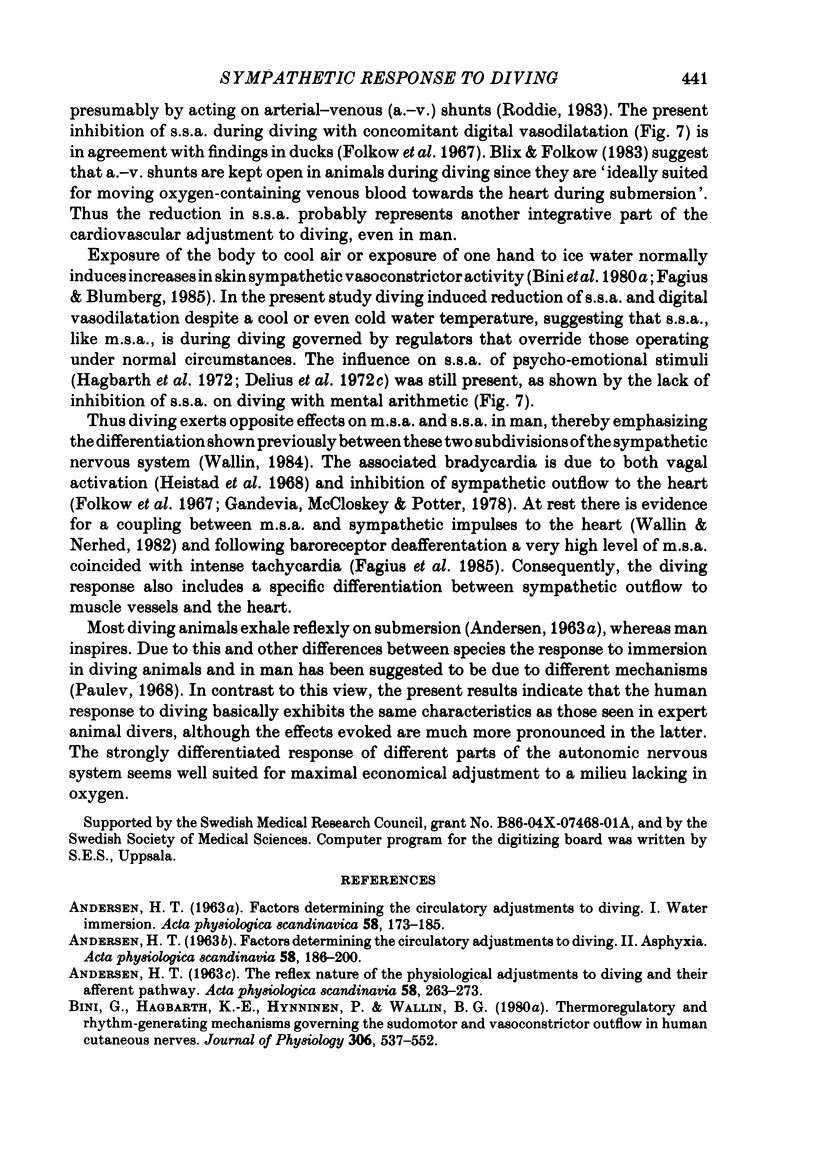

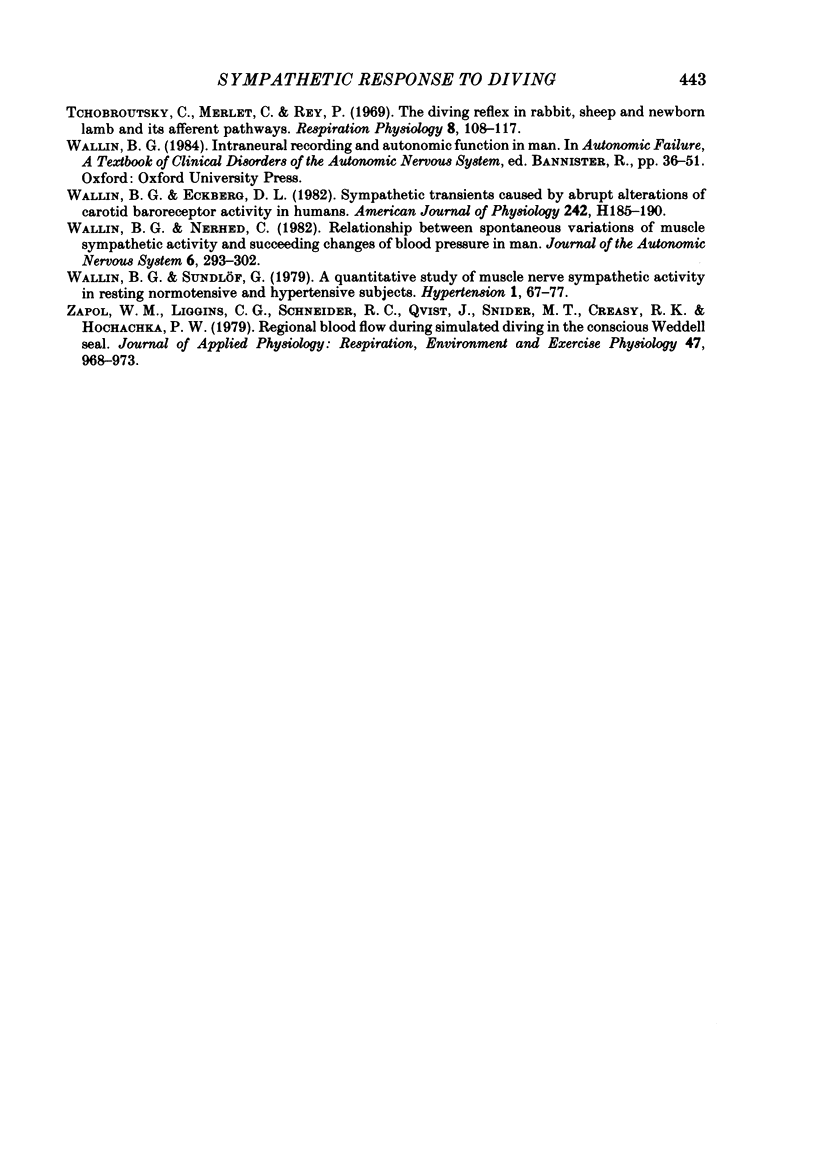
Selected References
These references are in PubMed. This may not be the complete list of references from this article.
- ANDERSEN H. T. Factors determining the circulatory adjustments to diving. I. Water immersion. Acta Physiol Scand. 1963 Jun-Jul;58:173–185. doi: 10.1111/j.1748-1716.1963.tb02639.x. [DOI] [PubMed] [Google Scholar]
- ANDERSEN H. T. Factors determining the circulatory adjustments to diving. II. Asphyxia. Acta Physiol Scand. 1963 Jun-Jul;58:186–200. doi: 10.1111/j.1748-1716.1963.tb02640.x. [DOI] [PubMed] [Google Scholar]
- ANDERSEN H. T. The reflex nature of the physiological adjustments to diving and their afferent pathway. Acta Physiol Scand. 1963 Jun-Jul;58:263–273. doi: 10.1111/j.1748-1716.1963.tb02648.x. [DOI] [PubMed] [Google Scholar]
- Bini G., Hagbarth K. E., Hynninen P., Wallin B. G. Regional similarities and differences in thermoregulatory vaso- and sudomotor tone. J Physiol. 1980 Sep;306:553–565. doi: 10.1113/jphysiol.1980.sp013414. [DOI] [PMC free article] [PubMed] [Google Scholar]
- Bini G., Hagbarth K. E., Hynninen P., Wallin B. G. Thermoregulatory and rhythm-generating mechanisms governing the sudomotor and vasoconstrictor outflow in human cutaneous nerves. J Physiol. 1980 Sep;306:537–552. doi: 10.1113/jphysiol.1980.sp013413. [DOI] [PMC free article] [PubMed] [Google Scholar]
- Campbell L. B., Gooden B. A., Horowitz J. D. Cardiovascular responses to partial and total immersion in man. J Physiol. 1969 May;202(1):239–250. doi: 10.1113/jphysiol.1969.sp008807. [DOI] [PMC free article] [PubMed] [Google Scholar]
- Delius W., Hagbarth K. E., Hongell A., Wallin B. G. General characteristics of sympathetic activity in human muscle nerves. Acta Physiol Scand. 1972 Jan;84(1):65–81. doi: 10.1111/j.1748-1716.1972.tb05158.x. [DOI] [PubMed] [Google Scholar]
- Delius W., Hagbarth K. E., Hongell A., Wallin B. G. Manoeuvres affecting sympathetic outflow in human muscle nerves. Acta Physiol Scand. 1972 Jan;84(1):82–94. doi: 10.1111/j.1748-1716.1972.tb05157.x. [DOI] [PubMed] [Google Scholar]
- Delius W., Hagbarth K. E., Hongell A., Wallin B. G. Manoeuvres affecting sympathetic outflow in human skin nerves. Acta Physiol Scand. 1972 Feb;84(2):177–186. doi: 10.1111/j.1748-1716.1972.tb05168.x. [DOI] [PubMed] [Google Scholar]
- Drummond P. C., Jones D. R. The initiation and maintenance of bradycardia in a diving mammal, the muskrat, Ondatra zibethica. J Physiol. 1979 May;290(2):253–271. doi: 10.1113/jphysiol.1979.sp012770. [DOI] [PMC free article] [PubMed] [Google Scholar]
- Dykes R. W. Factors related to the dive reflex in harbor seals: sensory contributions from the trigeminal region. Can J Physiol Pharmacol. 1974 Apr;52(2):259–265. doi: 10.1139/y74-035. [DOI] [PubMed] [Google Scholar]
- Fagius J., Blumberg H. Sympathetic outflow to the hand in patients with Raynaud's phenomenon. Cardiovasc Res. 1985 May;19(5):249–253. doi: 10.1093/cvr/19.5.249. [DOI] [PubMed] [Google Scholar]
- Fagius J., Wallin B. G., Sundlöf G., Nerhed C., Englesson S. Sympathetic outflow in man after anaesthesia of the glossopharyngeal and vagus nerves. Brain. 1985 Jun;108(Pt 2):423–438. doi: 10.1093/brain/108.2.423. [DOI] [PubMed] [Google Scholar]
- Fagius J., Wallin B. G. Sympathetic reflex latencies and conduction velocities in normal man. J Neurol Sci. 1980 Sep;47(3):433–448. doi: 10.1016/0022-510x(80)90098-2. [DOI] [PubMed] [Google Scholar]
- Folkow B., Nilsson N. J., Yonce L. R. Effects of "diving" on cardiac output in ducks. Acta Physiol Scand. 1967 Jul-Aug;70(3):347–361. doi: 10.1111/j.1748-1716.1967.tb03634.x. [DOI] [PubMed] [Google Scholar]
- Gandevia S. C., McCloskey D. I., Potter E. K. Reflex bradycardia occurring in response to diving, nasopharyngeal stimulation and ocular pressure, and its modification by respiration and swallowing. J Physiol. 1978 Mar;276:383–394. doi: 10.1113/jphysiol.1978.sp012241. [DOI] [PMC free article] [PubMed] [Google Scholar]
- Hagbarth K. E., Hallin R. G., Hongell A., Torebjörk H. E., Wallin B. G. General characteristics of sympathetic activity in human skin nerves. Acta Physiol Scand. 1972 Feb;84(2):164–176. doi: 10.1111/j.1748-1716.1972.tb05167.x. [DOI] [PubMed] [Google Scholar]
- Heistad D. D., Abbound F. M., Eckstein J. W. Vasoconstrictor response to simulated diving in man. J Appl Physiol. 1968 Nov;25(5):542–549. doi: 10.1152/jappl.1968.25.5.542. [DOI] [PubMed] [Google Scholar]
- Kawakami Y., Natelson B. H., DuBois A. R. Cardiovascular effects of face immersion and factors affecting diving reflex in man. J Appl Physiol. 1967 Dec;23(6):964–970. doi: 10.1152/jappl.1967.23.6.964. [DOI] [PubMed] [Google Scholar]
- Martner J., Wadenvik H., Lisander B. Apnoea and bradycardia from submersion in "chronically" decerebrated cats. Acta Physiol Scand. 1977 Dec;101(4):476–480. doi: 10.1111/j.1748-1716.1977.tb06031.x. [DOI] [PubMed] [Google Scholar]
- Moore T. O., Lin Y. C., Lally D. A., Hong S. K. Effects of temperature, immersion, and ambient pressure on human apneic bradycardia. J Appl Physiol. 1972 Jul;33(1):36–41. doi: 10.1152/jappl.1972.33.1.36. [DOI] [PubMed] [Google Scholar]
- Paulev P. E. Cardiac rhythm during breath-holding and water immersion in man. Acta Physiol Scand. 1968 May-Jun;73(1):139–150. doi: 10.1111/j.1748-1716.1968.tb04091.x. [DOI] [PubMed] [Google Scholar]
- Ross A., Steptoe A. Attenuation of the diving reflex in man by mental stimulation. J Physiol. 1980 May;302:387–393. doi: 10.1113/jphysiol.1980.sp013250. [DOI] [PMC free article] [PubMed] [Google Scholar]
- Song S. H., Lee W. K., Chung Y. A., Hong S. K. Mechanism of apneic bradycardia in man. J Appl Physiol. 1969 Sep;27(3):323–327. doi: 10.1152/jappl.1969.27.3.323. [DOI] [PubMed] [Google Scholar]
- Sundlöf G., Wallin B. G. Human muscle nerve sympathetic activity at rest. Relationship to blood pressure and age. J Physiol. 1978 Jan;274:621–637. doi: 10.1113/jphysiol.1978.sp012170. [DOI] [PMC free article] [PubMed] [Google Scholar]
- Sundlöf G., Wallin B. G. The variability of muscle nerve sympathetic activity in resting recumbent man. J Physiol. 1977 Nov;272(2):383–397. doi: 10.1113/jphysiol.1977.sp012050. [DOI] [PMC free article] [PubMed] [Google Scholar]
- Tchobroutsky C., Merlet C., Rey P. The diving reflex in rabbit, sheep and newborn lamb and its afferent pathways. Respir Physiol. 1969 Dec;8(1):108–117. doi: 10.1016/0034-5687(69)90048-6. [DOI] [PubMed] [Google Scholar]
- Wallin B. G., Eckberg D. L. Sympathetic transients caused by abrupt alterations of carotid baroreceptor activity in humans. Am J Physiol. 1982 Feb;242(2):H185–H190. doi: 10.1152/ajpheart.1982.242.2.H185. [DOI] [PubMed] [Google Scholar]
- Wallin B. G., Nerhed C. Relationship between spontaneous variations of muscle sympathetic activity and succeeding changes of blood pressure in man. J Auton Nerv Syst. 1982 Nov;6(3):293–302. doi: 10.1016/0165-1838(82)90002-9. [DOI] [PubMed] [Google Scholar]
- Wallin B. G., Sundlöf G. A quantitative study of muscle nerve sympathetic activity in resting normotensive and hypertensive subjects. Hypertension. 1979 Mar-Apr;1(2):67–77. doi: 10.1161/01.hyp.1.2.67. [DOI] [PubMed] [Google Scholar]
- Zapol W. M., Liggins G. C., Schneider R. C., Qvist J., Snider M. T., Creasy R. K., Hochachka P. W. Regional blood flow during simulated diving in the conscious Weddell seal. J Appl Physiol Respir Environ Exerc Physiol. 1979 Nov;47(5):968–973. doi: 10.1152/jappl.1979.47.5.968. [DOI] [PubMed] [Google Scholar]


